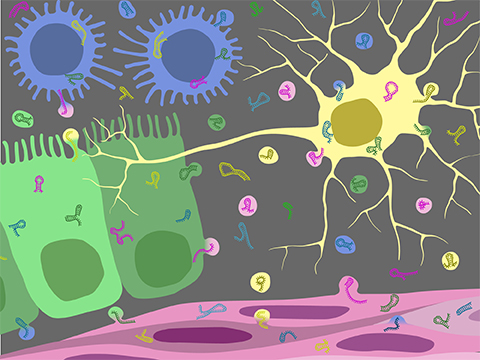New snapshots of RNA travels
High-density lipoprotein, or HDL, is a lipid and protein particle that carries cholesterol from the blood to the liver, where it is broken down and cleared from the body. Due to HDL’s role in this removal, the cholesterol attached to it is sometimes called good cholesterol.
However, cholesterol is only one of the many types of cargo transported by HDL particles. They also carry small extracellular RNAs that circulate in the blood from one destination to the next.
To investigate the movement of RNA from a cell to the lipoprotein carrier, researchers have had to isolate the RNA from the cell or the carrier and then perform quantitative polymerase chain reaction. This takes a lot of time and typically gives a low yield. Many processing steps increase sample loss and may isolate certain types of RNA selectively, thus hindering our understanding of extracellular RNA transport facilitated by HDLs.

In a recently published Journal of Lipid Research article, Kasey C. Vickers and his team at the Vanderbilt University Medical Center describe how they established a new method using SYTO RNASelect — a dye that specifically labels RNA — to quantify RNA in lipoprotein carriers.
The dye penetrates lipids and doesn’t light up or fluoresce until it’s bound to the RNA. Hence, SYTO RNASelect allows a researcher to observe RNAs in their natural state — you don’t need to isolate RNA or disrupt the lipid carrier to get the information you want.
In addition, with the SYTO dye, a researcher can look at the total flux of extracellular RNAs instead of picking a few candidate RNAs based on prior knowledge. “That’s a key advance in the field, as it has allowed us to make observations that we previously couldn’t see,” Vickers said.
Previous studies by this lab and others have indicated that macrophages, a type of immune cell, secrete RNAs that then tag along with HDLs for a ride. However, there’s been no prior evidence that the reverse flow is plausible — that HDLs also could deliver RNA to the macrophages. But using SYTO RNASelect dye, the team was able to visualize RNA transfer from HDLs to the macrophages for the first time.
Use of the dye opened doors to understanding how the flow of extracellular RNAs is altered in disease states. The study showed that HDL derived from patients with familial hypercholesterolemia, or FH, can accept more RNA from the macrophages than HDLs from healthy patients. However, the researchers have yet to understand the mechanism behind the increase in RNA loading of FH-derived HDLs.
“While this study is based on tissue culture, we are now expanding the use of labeled lipoproteins to animal models of atherosclerosis,” Vickers said.
Another application of this technology could be in RNA-based therapeutics. A clinician could label the nanoparticles delivering an RNA drug and then follow it to see where the drug is going and how quickly it is cleared out of the kidney.
Vickers hopes scientists will apply this reagent to other extracellular RNA carriers such as microvesicles and exosomes.
“The biggest antagonism the field of extracellular RNAs has faced is that the levels of circulating RNA are too low to make a meaningful contribution to cellular physiology,” he said. “But what we’re seeing with the use of this reagent is that there’s a huge discrepancy between the levels of naturally circulating RNA and what we observe by isolating RNA.”
Enjoy reading ASBMB Today?
Become a member to receive the print edition monthly and the digital edition weekly.
Learn moreGet the latest from ASBMB Today
Enter your email address, and we’ll send you a weekly email with recent articles, interviews and more.
Latest in Science
Science highlights or most popular articles

How a gene spurs tooth development
University of Iowa researchers find a clue in a rare genetic disorder’s missing chromosome.

New class of antimicrobials discovered in soil bacteria
Scientists have mined Streptomyces for antibiotics for nearly a century, but the newly identified umbrella toxin escaped notice.

New study finds potential targets at chromosome ends for degenerative disease prevention
UC Santa Cruz inventors of nanopore sequencing hail innovative use of their revolutionary genetic-reading technique.

From the journals: JLR
How lipogenesis works in liver steatosis. Removing protein aggregates from stressed cells. Linking plasma lipid profiles to cardiovascular health. Read about recent papers on these topics.

Small protein plays a big role in viral battles
Nef, an HIV accessory protein, manipulates protein expression in extracellular vesicles, leading to improved understanding of HIV-1 pathogenesis.

Genetics studies have a diversity problem that researchers struggle to fix
Researchers in South Carolina are trying to build a DNA database to better understand how genetics affects health risks. But they’re struggling to recruit enough Black participants.

